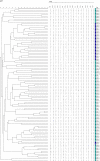Highly Discriminative Genotyping of Mycobacterium abscessus Complex Using a Set of Variable Number Tandem Repeats in China
- PMID: 35173692
- PMCID: PMC8841818
- DOI: 10.3389/fmicb.2021.802133
Highly Discriminative Genotyping of Mycobacterium abscessus Complex Using a Set of Variable Number Tandem Repeats in China
Abstract
In this study, our aims were to comparatively analyze the power of variable number tandem repeat (VNTR) typing to discriminate isolates within subspecies and to identify a potential genetic marker for better molecular typing of Mycobacterium abscessus complex (MABC) strains. A total of 103 clinical MABC isolates were collected from a nationwide cross-sectional study in China. Eighteen VNTR loci were chosen to genotype the MABC isolates. Of the 103 clinical MABC isolates, there were 76 (73.8%) M. abscessus subsp. abscessus (MAA) and 27 (26.2%) M. abscessus subsp. massiliense (MAM) isolates. Among the patients with MAA lung diseases, the percentage of patients older than 45 years (67.1%) was significantly higher than that of patients with MAM lung diseases [33.3%, adjusted odds ratio (aOR) = 0.36, 95% CI = 0.13-0.98, p = 0.046]. Fifteen VNTR loci were designated as being "highly discriminant" in our sample, except for TR109. The total of 103 MABC isolates were fully discriminated into 103 unique patterns by an 18-locus VNTR set [Hunter-Gaston Discriminatory Index (HGDI) = 1.000], of which the inclusion of the top 12 loci yielded a comparative HGDI value (HGDI = 0.9998). Remarkably, the order of the diversity of the VNTR loci showed significant difference between the MAA and MAM isolates. TR137 and TR2, two loci with high diversity indices for the MAA isolates, only yielded poor discriminatory power for the MAM isolates; the allelic diversity (h) values were 0.0000 and 0.2621, respectively. A detailed analysis of TR137 in combination with the other 17 VNTR loci showed that the combination of TR137-TR2 could fully distinguish MAA from MAM isolates. In conclusion, our data revealed that MAA is more prone to affect elderly patients. Additionally, the population structure of the MABC isolates circulating in China has high diversity. The combined use of the TR137 and TR2 loci provides a simple criterion for the precise identification of MABC to the subspecies level.
Keywords: MIRU-VNTR; Mycobacterium abscessus complex; genotyping; polymorphism; subspecies.
Copyright © 2022 Huang, Li, Ren, Zhang, Shang, Liu, Liu and Pang.
Conflict of interest statement
The authors declare that the research was conducted in the absence of any commercial or financial relationships that could be construed as a potential conflict of interest.
Figures




Similar articles
-
[Genetic research about Mycobacterium avium complex].Kekkaku. 2011 Feb;86(2):61-8. Kekkaku. 2011. PMID: 21404652 Japanese.
-
Genetic research about Mycobacterium avium complex.Kekkaku. 2013 Jan;88(1):17-22. Kekkaku. 2013. PMID: 23513564
-
Evaluation of customised lineage-specific sets of MIRU-VNTR loci for genotyping Mycobacterium tuberculosis complex isolates in Ghana.PLoS One. 2014 Mar 25;9(3):e92675. doi: 10.1371/journal.pone.0092675. eCollection 2014. PLoS One. 2014. PMID: 24667333 Free PMC article. Clinical Trial.
-
Mycobacterium abscessus Complex-Associated Chronic Meningitis: Time to Think Beyond Tuberculosis.Neurol India. 2023 Sep-Oct;71(5):946-952. doi: 10.4103/0028-3886.388095. Neurol India. 2023. PMID: 37929432 Review.
-
[New era in molecular epidemiology of tuberculosis in Japan].Kekkaku. 2006 Nov;81(11):693-707. Kekkaku. 2006. PMID: 17154049 Review. Japanese.
Cited by
-
Antimicrobial Effect of Oxazolidinones and Its Synergistic Effect with Bedaquiline Against Mycobacterium abscessus Complex.Infect Drug Resist. 2023 Jan 14;16:279-287. doi: 10.2147/IDR.S395750. eCollection 2023. Infect Drug Resist. 2023. PMID: 36683910 Free PMC article.
-
Rapid Detection of Clarithromycin and Amikacin Resistance in Mycobacterium abscessus Complex by High-Resolution Melting Curve Analysis.Microbiol Spectr. 2022 Jun 29;10(3):e0057422. doi: 10.1128/spectrum.00574-22. Epub 2022 May 31. Microbiol Spectr. 2022. PMID: 35638787 Free PMC article.
-
Isolation, characterization and therapeutic efficacy of lytic bacteriophage ZK22 against Salmonella Typhimurium in mice.BMC Microbiol. 2025 Jan 22;25(1):39. doi: 10.1186/s12866-025-03772-4. BMC Microbiol. 2025. PMID: 39844042 Free PMC article.
-
Prevalence of nontuberculous mycobacteria and the emergence of rare species in Henan Province, China.Epidemiol Infect. 2024 May 6;152:e92. doi: 10.1017/S095026882400061X. Epidemiol Infect. 2024. PMID: 38708766 Free PMC article.
-
Genomic characterization of a novel bacteriophage STP55 revealed its prominent capacity in disrupting the dual-species biofilm formed by Salmonella Typhimurium and Escherichia coli O157: H7 strains.Arch Microbiol. 2022 Sep 3;204(10):597. doi: 10.1007/s00203-022-03208-x. Arch Microbiol. 2022. PMID: 36056994
References
-
- Brown-Elliott B. A., Vasireddy S., Vasireddy R., Iakhiaeva E., Howard S. T., Nash K., et al. (2015). Utility of sequencing the erm(41) gene in isolates of Mycobacterium abscessus subsp. abscessus with low and intermediate clarithromycin MICs. J. Clin. Microbiol. 53 1211–1215. 10.1128/JCM.02950-14 - DOI - PMC - PubMed
-
- Bryant J. M., Grogono D. M., Greaves D., Foweraker J., Roddick I., Inns T., et al. (2013). Whole-genome sequencing to identify transmission of Mycobacterium abscessus between patients with cystic fibrosis: a retrospective cohort study. Lancet 381 1551–1560. 10.1016/S0140-6736(13)60632-7 - DOI - PMC - PubMed
-
- Choi G. E., Chang C. L., Whang J., Kim H. J., Kwon O. J., Koh W. J., et al. (2011). Efficient differentiation of Mycobacterium abscessus complex isolates to the species level by a novel PCR-based variable-number tandem-repeat assay. J. Clin. Microbiol. 49 1107–1109. 10.1128/JCM.02318-10 - DOI - PMC - PubMed
LinkOut - more resources
Full Text Sources
Molecular Biology Databases
Research Materials

